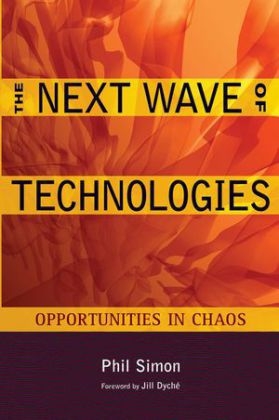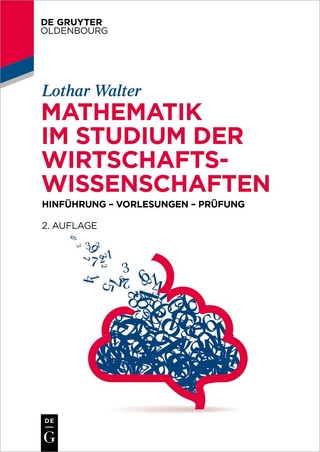
The Next Wave of Technologies
John Wiley & Sons Inc (Verlag)
978-0-470-58750-8 (ISBN)
Your all-inclusive guide to all the latest technologies Providing you with a better understanding of the latest technologies, including Cloud Computing, Software as a Service, Service-Oriented Architecture (SOA), Open Source, Mobile Computing, Social Networking, and Business Intelligence, The Next Wave of Technologies: Opportunities in Chaos helps you know which questions to ask when considering if a specific technology is right for your organization.
Demystifies powerful but largely misunderstood technologies
Explains how each technology works
Provides key guidance on determining if a particular technology is right for your organization
Contains contributions from experts on Cloud Computing, Service-Oriented Architecture (SOA), Software as a Service (SaaS), Open Source, Mobile Technologies, Enterprise Risk Management, Social Media, Business Intelligence, and more
More of a management text than a technical guide, the book is designed to help your organization better understand these exciting new technologies and their potential impact. The Next Wave of Technologies: Opportunities in Chaos will help you determine if your organization is ready for a specific technology, how to prepare for its successful adoption, how to measure success, and the key risks and red flags to recognize.
PHIL SIMON is a recognized business technology expert and independent consultant. He is the author of Why New Systems Fail, a critically acclaimed book about IT management. He consults, speaks, and regularly contributes to a number of different technology-oriented sites. Phil holds degrees from Carnegie Mellon University and Cornell University. You can find out more about Phil by visiting his site: www.philsimonsystems.com.
Foreword. Preface.
Acknowledgments.
About the Contributors.
Part I Introduction, Background, and Definitions.
Chapter 1 The Changing Landscapes of Business and Technology.
Introduction.
Enterprise 2.0: What's in a Name, Anyway?
Understanding the Caution.
Electronic Health Records (EHR): A Case in Point.
Summary.
Chapter 2 How the Game Has Changed.
Introduction.
The Typical Enterprise 1.0 Project.
Comparing Enterprise 1.0 and 2.0 Projects.
Three Requirements to Successful Enterprise 2.0 Projects.
Scopes, Scales, and Reaches.
Unstructured Development and Alternatives to the Waterfall.
Summary.
Next Steps.
Chapter 3 The Role of IT in an Enterprise 2.0 World.
Introduction.
Collins' Model.
IT's Traditional Charter.
Considerations.
Three Viewpoints.
The Changing Role of the CIO.
Summary.
Next Steps.
Part II Architecture, Software Development, and Frameworks.
Chapter 4 Cloud Computing.
A Brief History of Cloud Computing.
Consumers and Small Office Home Office (SOHO) versus the Enterprise.
A Cloud of One's Own.
What is a Cloud?
Definitions of Cloud Computing.
Cloud Manifesto.
Cloud Architecture.
The Private Cloud: When Is a Cloud Not a Cloud?
Cloud Economics.
Vendor Strategies.
Customer Strategies.
Standards and Interoperability.
Security.
The Future of Clouds.
Summary.
Next Steps.
Chapter 5 Open Source: The War That Both Sides Won.
Introduction.
A New Geography for Software.
When UNIX Walked the Earth.
Co-Opted by the System.
What Is Open Source?
The Costs of Free Software.
Is it a Virus? Legal Risks to Using Open Source.
The New Green.
The Future of Open Source.
Summary.
Next Steps.
Chapter 6 Software as a Service (SaaS).
Introduction.
Nothing's New: SaaS' Historical Precedents.
What's Different This Time?
Customer Expectations.
Challenges and Choices.
Summary.
Next Steps.
Chapter 7 Service-Oriented Architecture.
Introduction.
What is Service-Oriented Architecture?
Business Benefits of SOA.
Technical Benefits of SOA.
Essentials of SOA.
SOA in Practice.
Lessons Learned.
Best Practices.
Summary.
Next Steps.
Chapter 8 Managing Mobile Business.
Introduction.
An Introduction to Mobility.
The Mobile Enterprise.
Risks and Considerations.
Business Expectations from Mobile Technologies.
The Mobile Enterprise Transition Framework.
Phases of Mobile Enterprise Transition.
Business Value of Mobile Technologies.
Metrics.
Mobile Organizational Structures.
Mobile Content and Services.
Mobile Business Application Considerations.
Balancing Personal Services with Privacy.
Summary.
Next Steps.
Chapter 9 Social Networking.
Introduction.
Why Social Networking and Why Not Just Use the Public Forums?
Benefits of Social Networking.
Impediments, Solutions, and Resolutions to Progress.
Examples of Social Networking Tools.
Summary.
Next Steps.
Part III Data, Information, and Knowledge.
Chapter 10 Enterprise Search and Retrieval.
Introduction.
What Is ESR?
Search and Information Architecture.
The Business Case for ESR.
Total Cost of Ownership.
Forms of ESR Deployment.
ESR in Action.
Best Practices.
Summary.
Next Steps.
Chapter 11 Enterprise 2.0 Business Intelligence.
What Is Business Intelligence and Why Do We Need It?
BI 2.0.
Measuring BI Maturity.
BI Challenges.
The Data Warehouse.
Key Factors.
Recent BI Trends.
Too Much BI?
Summary.
Next Steps.
Chapter 12 Master Data Management.
Introduction.
The State of the Union.
The Business Case for Master Data Management.
MDM Approaches and Architectures.
Selecting the Right MDM Approach.
MDM Services and Components.
Summary.
Next Steps.
Chapter 13 Procurement in Chaos.
Introduction.
Does Procure-to-Pay Matter?
What Is Procure-to-Pay Automation?
Benefiting from P2P Automation.
Procure-to-Pay Leadership.
Automation Risks and Challenges.
Leveraging your ERP.
Technology Overview.
Vendor Portals.
Summary: Rethinking Procurement.
Next Steps.
Part IV Management and Deployment.
Chapter 14 Agile Software Development.
Introduction.
Limitations of the Waterfall Method of Software Development.
Benefits of Agile Methods.
Alternative Engineering Models.
Agile Process in a Nutshell.
The Agile Landscape.
The Benefits of Simplicity.
The Manager's Perspective.
Limitations of Agile.
Achieving Enterprise Agility.
Summary.
Next Steps.
Chapter 15 Enterprise Risk Management.
The High-Risk Society.
Information Technology and the High-Risk Society.
Enterprise Risk Management Overview.
ERM and IT.
ERM, Innovation, and Entrepreneurship.
Who Owns ERM?
Who Is Doing ERM?
The Limits of ERM.
Summary.
Next Steps: Are You Ready for ERM?
Chapter 16 Implementing Open Source Software.
Introduction.
A Different Software Model.
Getting into Open Source.
OS and Digital Presence.
OS and Managing Your Business.
Appearances Can Be Deceiving.
Product Development Agility.
Support.
Product Types.
Crowdsourcing.
Niche Markets.
Summary.
Next Steps.
Chapter 17 Global Engineering.
Introduction.
Distributed Teams: An Integral Part of Enterprise 2.0.
Room for Improvement.
Preconditions and Reasons for Distributing Technology Projects.
Drivers of Global IT.
Why International Distributed Projects Sometimes Fail.
Global Engineering 2.0.
Summary.
Next Steps.
Chapter 18 Enterprise 2.0 IT Project Failure.
Introduction.
Enterprise 2.0: An Evolving Concept.
Understanding Traditional IT Failure.
Enterprise 2.0 Failure.
Reasons Enterprise 2.0 Projects Fail.
Case Study: Social CRM.
Preventing Failure through Measurement.
Summary.
Next Steps.
Chapter 19 Readying the Troops for Battle.
Introduction.
Know Your Organization's Limitations from the Get-Go.
Insist on Maximum Collaboration with External Parties.
Bridge the Gap between Functional and Technical End Users.
Prepare for Sudden, Unexpected Growth.
Recommit to Employee Training.
Embrace Uncertainty to Foster Innovation.
Flip the Switch: Reverse Mentoring.
Summary.
Next Steps.
Chapter 20 Sustainability and Green IT.
Introduction.
Growing Impact on Organizations.
The Green Fad.
Organizational Response to Sustainability.
The Future of Green IT.
Summary.
Next Steps.
Part V Conclusion.
Chapter 21 Finding Opportunity in Chaos.
Introduction.
Summary of Book.
Where Are We Now?
Enterprise 2.0 Drivers
Where Are We Going?
Bibliography.
About the Author.
Index.
| Vorwort | Jill Dyché |
|---|---|
| Zusatzinfo | Photos: 5 B&W, 0 Color; Drawings: 26 B&W, 0 Color; Tables: 20 B&W, 0 Color; Exhibits: 0 B&W, 0 Color |
| Verlagsort | New York |
| Sprache | englisch |
| Maße | 160 x 236 mm |
| Gewicht | 676 g |
| Einbandart | gebunden |
| Themenwelt | Mathematik / Informatik ► Informatik |
| Mathematik / Informatik ► Mathematik ► Finanz- / Wirtschaftsmathematik | |
| Wirtschaft ► Betriebswirtschaft / Management | |
| ISBN-10 | 0-470-58750-4 / 0470587504 |
| ISBN-13 | 978-0-470-58750-8 / 9780470587508 |
| Zustand | Neuware |
| Haben Sie eine Frage zum Produkt? |
aus dem Bereich


